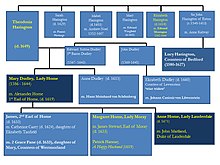Elizabeth Harington
Elizabeth Harington (died in 1618) was an English aristocrat.
Life

Elizabeth Harington was the daughter of
After her husband died in 1602, Elizabeth lived at Hemington.[5] Though her eyesight deteriorated with age, she continued to work on her embroidery. In July 1616, when King James came to hunt in nearby Geddington woods during his progress through Northamptonshire, her eldest son Edward showed the King a handkerchief that his mother had sewn as a "wonder", and they spoke of her good works and piety.[6]

Elizabeth Montagu died on 19 May 1618.[7]
Will and bequests
Amongst the bequests in her will, she gave pieces of unicorn horn set in gold to her daughter Elizabeth, Lady Willoughby, and to Sarah, Lady Zouche. She left a "Booke of goulde" to her granddaughter Bessie Capell, and some items of silver plate to Theodosia, Lady Dudley, including a silver pot for her "uscubath", meaning whisky: uisge beatha or usquebaugh.[8] She gave a velvet cabinet with a purse of gold coins in one of its drawers or "boxes" to Theodosia's daughter, Margaret Dudley Hobart. She gave Anne, Lady Harington a silver "posnet" dish and cover which had belonged to Mary, Queen of Scots.[9]
Mary, Queen of Scots, owned a silver posnet, which she used for "bouillon" or broth at Wingfield Manor.[10] It was listed in 1587 at Fotheringhay amongst silver in the keeping of Elizabeth Curle, sister of Gilbert Curle, said to have been Mary's gift to her priest.[11]
Family
Her children included:
- Edward Montagu, 1st Baron Montagu of Boughton
- Henry Montagu, 1st Earl of Manchester
- Sir Charles Montagu
- James Montagu, Bishop of Winchester.
- Sir Sidney Montagu, ancestor of the Earls of Sandwich.
- Lucy Montagu who married Sir William Wray, 1st Baronet, of Glentworth
- Elizabeth Montagu, who married Robert Bertie
- Theodosia Montagu, who married Sir Henry Capell, their son was Arthur Capell, 1st Baron Capell of Hadham
References
- ^ Patricia Phillipy, 'Literary Legacies in the Montagu Archive', Naomi J. Miller & Diane Purkiss, Literary Cultures and Medieval and Early Modern Childhoods, p. 318.
- ^ MONTAGU, Edward I (c.1530-1602), of Boughton, The History of Parliament: the House of Commons 1558-1603, ed. P.W. Hasler, 1981
- ^ Elizabeth Goldring, Faith Eales, Elizabeth Clarke, Jayne Elisabeth Archer, John Nichols's The Progresses and Public Processions of Queen Elizabeth, 1579-1595, vol. 3 (Oxford, 2014), p. 371.
- ^ Arthur Collins, Letters and Memorial of State, vol. 1 (London, 1746), p. 81.
- ^ HEMINGTON Beaulieu Hall, Historic England
- ^ Patricia Phillipy, Shaping Remembrance from Shakespeare to Milton (Cambridge, 2018), pp. 59-60.
- ^ Patricia Phillipy, Shaping Remembrance from Shakespeare to Milton (Cambridge, 2018), p. 70.
- ^ This reference to "uscubath" is quoted in, George Cockayne, Complete Peerage (London, 1932), p. 365.
- ^ Patricia Phillipy, Shaping Remembrance from Shakespeare to Milton (Cambridge, 2018), p. 70: Will of Elizabeth Montague, TNA PROB 11/131/760.
- ^ William Boyd, Calendar State Papers Scotland, vol. 7 (London, 1913), p. 460 no. 433.
- ^ A. Labanoff, Lettres de Marie Stuart, vol. 7 (London, 1842), p. 262.
